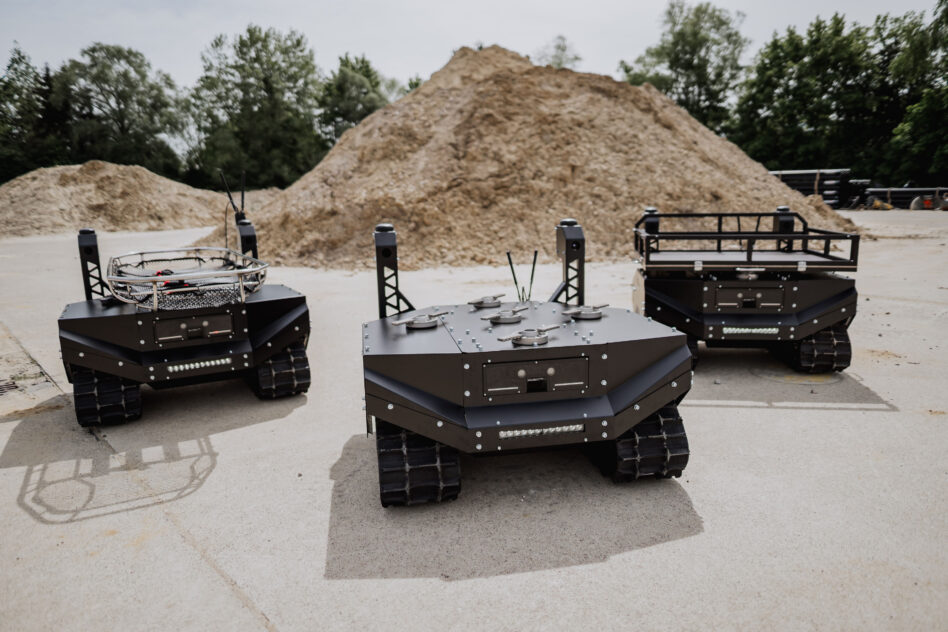Remember when we said that everyone loves a little baby tank? Well, ARX Robotics is back to prove our point.
Yesterday, the German unmanned ground vehicle (UGV) company announced that it’s secured a “significant major order” from Ukraine—financed by the German government—for its Gereon UGVs.
ARX UK CEO David Roberts told Tectonic that with the new order, there will now be “hundreds” of ARX robots being used by “at least ten units” on the battlefield in Ukraine. (Roberts declined to give specific numbers for security reasons.)
“Several hundred vehicles will now be connected and working together in Ukraine, essentially in order to improve the survivability of soldiers,” he said, “[They are] able to operate in those areas where you want to try to remove soldiers where possible.”
As part of the deal, the company will also set up a manufacturing line in Ukraine over the next six months.
“I think it’s incredibly important that we do work in Ukraine and with Ukrainians to make sure the manufacturing base is also benefiting,” Roberts added.
Roll through: First, a bit about ARX. The company was founded in 2021 by former members of the German Armed Forces who wanted to create unmanned and autonomous ground systems that could keep soldiers out of harm’s way.
The company’s flagship product is a small, tracked UGV—essentially what looks like a baby tank—called Gereon.
- The OG model can carry up to a 500kg payload and (to date) was designed for everything from frontline logistics to casualty evacuation and surveillance.
- It can travel at top speeds of about 30 kph (18.64 mph) and has a range of 40 km (24.85 miles).
- Earlier this year, the company unveiled a combat-hardened version of the UGV called Combat Gereon (on the nose), which essentially has a coat of armor and can carry integrated weapons systems (think: go boom).
And investors around the world seem to really like what ARX is selling. The company raised a €31M ($36.2M) Series A back in April, then tacked on an additional €11M ($12.86M) Series A extension in July, bringing the round to $42M. Not too shabby.
- The company has also inked a range of partnerships, including with European defense tech giant Helsing, German prime RENK group, and Daimler Truck.
Helping hand: Roberts said that the vast majority of the new UGVs in Ukraine will be the OG Gereon model and will be used for logistics, resupply, and evacs.
“Taking out logistics to the front line—water, food, ammunition, cigarettes—is happening on a daily basis,” Roberts said, “When there is constant surveillance and people are under threat when they’re doing those missions, clearly using a robot makes sense.”
This is particularly true for the more gruesome missions that happen in war—medical and casualty evacuations.
“When you’re withdrawing a casualty, if that were previously done with a pickup or with a quad bike, you’d be putting not just the casualty at risk, but also the person driving them back,” he added. FPVs can target Gereon without putting an additional life at risk.
Pushing buttons: While the robotic vehicle can operate autonomously, Roberts said, most of the units in Ukraine are remotely controlling Gereon.
“With the terrain being quite changeable in Ukraine, we normally work on a tele-operated basis,” he said, using the fancy word for remote-controlled. “It really comes down to the individual units as to how they want to try to employ the vehicle.”
All in all, he said that this order (and the success of ARX) shows that forces are starting to focus on survivability—protecting their troops—rather than just lethality. And he only expects this trend to increase.
“You need to be able to protect your guys as well,” he said, “I think in order to be able to provide that survivability, there’s going to be a natural increase in the number of UGVs operating to make sure soldiers are kept safe.”

